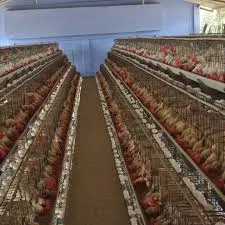Exploring the Benefits and Drawbacks of Broiler Battery Cages in Poultry Farming
Aug . 18, 2024 10:36 Back to list
Exploring the Benefits and Drawbacks of Broiler Battery Cages in Poultry Farming
The Controversy Surrounding Broiler Battery Cages
In the discourse surrounding animal welfare and industrial agriculture, few topics ignite as much debate as broiler battery cages
. These cages, designed primarily for the intense production of poultry, have been a staple in the commercial farming industry for decades. However, the practices associated with their use raise significant ethical and welfare concerns that merit a closer examination.Broiler chickens, bred specifically for meat production, are often raised in crowded, unsanitary conditions that prioritize efficiency and profit above the animals' well-being. Battery cages, typically small enclosures that can house several birds, have been widely adopted due to their economic advantages. These cages allow for high-density farming, making it easier for farmers to manage large flocks. Proponents argue that this method maximizes space and reduces costs, thus providing a more stable food supply to meet global demands.
However, the welfare implications of battery cages are severe. One of the most significant criticisms is the lack of adequate space for the birds. Broiler chickens in battery cages are often unable to engage in natural behaviors such as roaming, foraging, and socializing, which are crucial for their physical and mental health. The confined space can lead to stress, aggression, and injuries among the birds, raising questions about the ethics of such farming practices. Furthermore, the high stocking density in these cages can contribute to the rapid spread of disease, necessitating the use of antibiotics, which can have broader implications for public health and antibiotic resistance.
broiler battery cages

Animal welfare organizations and activists have been vocal in their opposition to the use of broiler battery cages. Numerous studies have highlighted the psychological and physiological issues faced by birds kept in these conditions. As a result, there has been a growing movement advocating for the adoption of more humane alternatives, such as free-range or barn-raised systems, which allow chickens more freedom to move and behave naturally. These alternatives, while potentially more costly for producers, have gained traction among consumers who increasingly prioritize ethically sourced food.
In response to public pressure and evolving consumer expectations, some countries and companies have begun to phase out battery cages entirely. European nations such as Germany and Switzerland have implemented strict regulations against their use, promoting welfare-friendly practices instead. This shift reflects a broader trend in the food industry toward transparency and responsibility, as consumers demand to know where their food comes from and under what conditions it was produced.
However, the transition away from battery cages is not without challenges. For many farmers, the initial costs of upgrading facilities to accommodate more humane systems can be daunting. Moreover, the structural changes required to support a free-range operation necessitate significant planning and investment. Balancing animal welfare with commercial viability remains a contentious issue, particularly in regions where traditional farming practices are deeply entrenched.
In conclusion, the issue of broiler battery cages sits at the intersection of agricultural efficiency and animal welfare. As consumer awareness and activism continue to grow, the industry is faced with the challenge of finding sustainable, humane solutions that can accommodate both the demand for poultry and the ethical treatment of animals. It is a complex dilemma that requires cooperation from farmers, consumers, and policymakers alike to chart a path forward that respects both economic and ethical considerations. Ultimately, the future of poultry farming will depend on our collective willingness to foster practices that prioritize the well-being of animals while meeting the needs of a growing population.
-
Hot Sale 24 & 18 Door Rabbit Cages - Premium Breeding Solutions
NewsJul.25,2025
-
Automatic Feeding Line System Pan Feeder Nipple Drinker - Anping County Yize Metal Products Co., Ltd.
NewsJul.21,2025
-
Automatic Feeding Line System Pan Feeder Nipple Drinker - Anping County Yize Metal Products Co., Ltd.
NewsJul.21,2025
-
Automatic Feeding Line System - Anping Yize | Precision & Nipple
NewsJul.21,2025
-
Automatic Feeding Line System - Anping Yize | Precision & Nipple
NewsJul.21,2025
-
Automatic Feeding Line System-Anping County Yize Metal Products Co., Ltd.|Efficient Feed Distribution&Customized Animal Farming Solutions
NewsJul.21,2025






